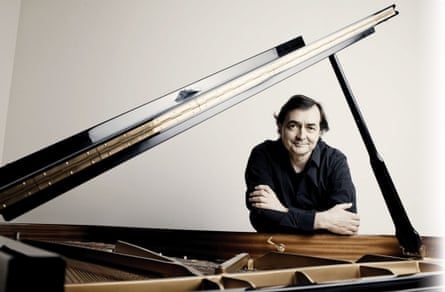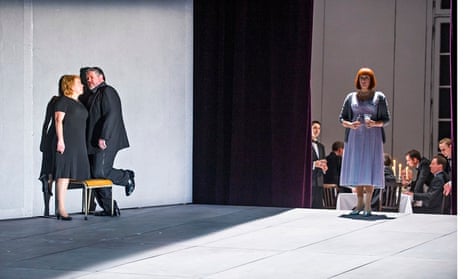Early in the gestation of Tristan und Isolde, Wagner organised a solo read-through of the libretto – written, as usual, by himself – to a few friends who included a potent trio: his wife, Minna, his latest object of desire, Mathilde Wesendonck, and his future wife, Cosima, still comfortably married to his loyal friend, the conductor Hans von Bülow.
By the time of the opera’s first performance in 1865, Minna and Mathilde were toast. Wagner and Cosima were lovers, with a daughter, Isolde, just weeks old. Von Bülow, with feelings we can only guess at, conducted the premiere of one of the world’s great love epics. If the details – who knew what and when – are complicated, the frightening impact of this true-life drama is immediate.
The same could be said of Tristan und Isolde itself, which returned to the Royal Opera House last week in a riveting revival of Christof Loy’s 2009 production. A Cornish knight falls for his uncle’s Irish princess bride thanks to a love potion. Ecstasy and tragedy ensue. Raw emotion is the chief narrator. The complication comes in the backstory. Tristan is a tiny episode cut from the bigger tapestry of Arthurian romance with threads still hanging: past deeds, familial ties, old enmities.
Loy’s production, peopled upstage with men in dinner jackets craning their necks at the love-blind pair, is astute in suggesting this backdrop. The stage is often empty but for the protagonists, yet you know the eyes of society are always upstage, behind a curtain. This revival is even better than the first staging: well-defined, detailed but unfussy, choreographed but not mannered. Two of the world’s leading Wagnerians at the top of their game, Stephen Gould and Nina Stemme, sang the title roles, with Antonio Pappano conducting – a mild verb to describe his extraordinary workout on the podium, a near physical and mental enactment of each bar of this four-and-a-half hour masterpiece.
Gould was tireless, hitting every high note with resounding accuracy, performing with dignity and barely contained intensity. Stemme is peerless as a formidable, urgent Isolde. Sarah Connolly makes a spellbinding Brangane, Iain Paterson is touching as Kurwenal, at first bluff and slightly beery but ever more troubled. John Tomlinson uses his lifetime experience of singing Wagner to play King Marke, a husk of a figure, betrayed but still dignified and generous. Graham Clark, Ed Lyon and Neal Cooper give excellent support. Some vocal weaknesses were reported on the first night. I attended the second, when all sounded secure, Pappano, cast and orchestra thrilling and unforgettable.
As part of a weekend of events at the Southbank to mark the culmination of Harrison Birtwistle’s 80th birthday year, the London Philharmonic Orchestra gave the UK premiere of his 25-minute work for piano and orchestra, Responses: Sweet disorder and the carefully careless. It had a particular resonance for me as I had seen the work’s growth while writing a book with Birtwistle last year. Its progress, the stops, starts and agonies, turned into a central part of the narrative.

Hearing it played by its dedicatee, the pianist Pierre-Laurent Aimard, was like meeting someone with whom you have only exchanged emails, familiar yet wholly unexpected. The title, Responses, indicates the relationship between soloist and orchestra. Musical material hardly overlaps. Questions are posed on either side. Birtwistle describes it as “hocketing”, a favourite technique of his borrowed from medieval music, in which a line is shared between instruments or voices alternating. The result is not combat – the more traditional concerto habit – but quick-fire dialogue.
From the first scintillating rattle of tambourine, crasher and castanet machine, into which the piano bursts with a swift flourish, to the final, hushed violin harmonics, shape and intention are clear. Apparently similar patterns change minutely, invented afresh with each appearance. Muted brass, wah-wahing distinctively, offsets long woodwind lines. Aural timbres are spare rather than lush, taut but lyrical.
In the penultimate bar, tubular bells are struck for the first time, creating (with vibraphone and crotales) an unearthly metallic chime to end the work. The piano’s final notes sound only when all else has died away, a nonchalant upbeat, as if opening a door to a new adventure. Vladimir Jurowski, conducting, and the LPO played with crisp precision. Aimard, having already played it in Germany and Portugal, was fluent and commanding.
Birtwistle would happily use ping-pong balls, pots and pans or an exploding balloon in his percussion section if so required. These were some of the instruments, together with strings, woodwind, piano, celeste and toy piano, which turned up in The Way Back Home, a new children’s opera for 5- to 8-year-olds, created by Katie Mitchell and Vicki Mortimer with music by Joanna Lee, a student of Oliver Knussen and, last year, apprentice composer in residence with BCMG. Based on the book by Oliver Jeffers with a libretto by Rory Mullarkey – everyone in this exuberant production deserves a credit – it’s about a boy who finds an aeroplane and crash-lands it on the moon, where he meets a lost Martian with a charming Irish accent (soprano Aoife O’Sullivan).

The 50-minute piece, commissioned by English National Opera and performed at the Young Vic, moves fast, is easy to hear, looks colourful and cheery and above all is a real opera: sung, with a quartet of carrot-top characters called Gizmos who make plane noises (bzzzzzzzz or click-click-click or creeeeeaaak) and a trouser role (the boy is sung by mezzo Victoria Simmonds). Lee’s music is brilliantly witty.
An adorable fat penguin, almost what you’d call dumpy, stole the show. When he (Peter Hobday) stripped off his costume to take a bow, it was all an illusion: he is tall and slim. That’s the magic of theatre. The conductor, Stephen Higgins, wears a crazy orange wig, which could catch on.
- Tristan und Isolde continues in rep at the Royal Opera House, London WC2 until 21 December
- The Way Back Home is at the Young Vic, London SE1 until 23 December

Comments (…)
Sign in or create your Guardian account to join the discussion